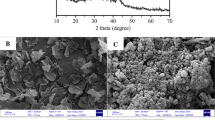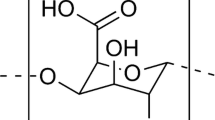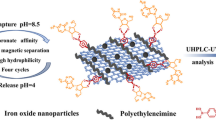Abstract
A novel and efficient Graphene Oxide-Polyethylene Glycol mono-4-nonylphenyl Ether (GO-PEGPE) nanocomposite was synthesized and used for solid phase extraction of trace levels of Pb2+ in different water and blood samples. The synthesized adsorbent was then characterized by the Fourier Transform-Infrared spectrophotometry (FT-IR), Field Emission-Scanning Electron Microscopy (FE-SEM), Energy dispersive X-ray spectroscopy (EDX) and X-ray diffraction analysis (XRD). To optimize the critical parameters including pH of samples solution, amounts of adsorbent and extraction time, the response surface methodology based on the central composite design (RSM-CCD) was used and based on the results, pH = 6.0, extraction time = 22 min and amounts of adsorbent = 15 mg were selected as the optimum conditions. The relative standard deviation based on seven replicate analysis of 2 µg L−1 Pb2+ was 5.2% and the limit of detection was 0.023 µg L−1 (n = 8). The results of adsorption isotherm investigation show that the adsorption of Pb2+ onto the GO-PEGPE nanocomposite obeyed by the Langmuir isotherm with the maximum adsorption capacity of 69.44 mg g−1. Also, based on the Temkin and Dubinin–Radushkevich (DR) isotherms, the adsorption of Pb2+ onto the GO-PEGPE nanocomposite is a physisorption phenomenon and the consequences of the kinetic models illustrated that the adsorption of Pb2+ followed by the pseudo second order adsorption kinetic model. Finally, the proposed method was successfully applied for preconcentration of Pb2+ in different water and blood samples of turning industry workers.













Similar content being viewed by others
References
Lach J, Wróbel K, Wróbel J, Podsadni P, Czerwiński A. Applications of carbon in lead-acid batteries: a review. J Solid State Electrochem. 2019;23:693–705.
Felder A, Prengaman RD. Lead alloys for permanent anodes in the nonferrous metals industry. JOM. 2006;58:28–31.
Wani Ab L, Ara A, Usmani JA. Lead toxicity: a review. Interdiscip Toxicol. 2015;8(2):55–64.
Flora G, Gupta D, Tiwari A. Toxicity of lead: a review with recent updates. Interdiscip Toxicol. 2012;5(2):47–58.
Al-Kinani A, Eftekhari M, Gheibi M, Chamsaz M. Polyaniline-coated cerium oxide nanoparticles as an efficient adsorbent for preconcentration of ultra-trace levels of cadmium (II) followed by electrothermal atomic absorption spectrometry. Spectrosc Lett. 2018;51:287–96.
Feist B. Selective dispersive micro solid-phase extraction using oxidized multiwalled carbon nanotubes modified with 1, 10-phenanthroline for preconcentration of lead ions. Food Chem. 2016;209:37–42.
Alawadi M, Eftekhari M, Gheibi M, Iranzad F, Chamsaz M. Synthesis of silver nanoparticles by pistachio skin extract and its application for solid phase extraction of Bi(III) followed by electrothermal atomic absorption spectrometry. Chem Pap. 2019;73:2041–51.
Altunay N, Hazer B, Tuzen M, Elik A. A new analytical approach for preconcentration, separation and determination of Pb(II) and Cd(II) in real samples using a new adsorbent: Synthesis, characterization and application. Food Chem. 2021;359: 129923.
Tuzen M, Elik A, Hazer B, Şimşek S, Altunay N. Poly(styrene)-co-2-vinylpyridine copolymer as a novel solid-phase adsorbent for determination of manganese and zinc in foods and vegetables by FAAS. Food Chem. 2020;333: 127504.
Uzcan F, Soylak M. CuCo2O4 as affective adsorbent for dispersive solid-phase extraction of lead from food, cigarette and water samples before FAAS detection. Chem Pap. 2021;75:6367–75.
Mashhadizadeh MH, Pesteh M, Talakesh M, Sheikhshoaie I, Mazloum Ardakani M, Karimi MA. Solid phase extraction of copper (II) by sorption on octadecyl silica membrane disk modified with a new Schiff base and determination with atomic absorption spectrometry. Spectrochim Acta B At Spectrosc. 2008;63:885–8.
Siva Kumar N, Dharmendra V, Sreenivasulu V, Asif M, Ibrahim AA, Balaram V. Separation and pre-concentration of Pb and Cd in water samples using 3-(2-hydroxyphenyl)-1H-1,2,4-triazole-5(4H)-thione (HTT) and their determination by Inductively Coupled Plasma Atomic Emission Spectrometry (ICP-AES). Metals. 2017;7:240.
Naresh Kumar B, Ramana V, Harinath Y, Seshaiah K, Wang MC. Separation and preconcentration of Cd(II), Cu(II), Ni(II), and Pb(II) in water and food samples using amberlite XAD-2 functionalized with 3-(2-Nitrophenyl)-1H-1,2,4-triazole-5(4H)-thione and determination by Inductively Coupled Plasma-Atomic Emission Spectrometry. J Agric Food Chem. 2011;59:11352–8.
Eigler S, Grimm S, Hof F, Hirsch A. Graphene oxide: a stable carbon framework for functionalization. J Mater Chem A. 2013;1:11559–62.
Chen D, Feng H, Li J. Graphene oxide: preparation, functionalization, and electrochemical applications. Chem Rev. 2012;112:6027–53.
Azari A, Mahmoudian MH, Hazrati Niari M, Eş I, Dehganifard E, Kiani A, Javid A, Azari H, Fakhri Y, Mousavi KA. Rapid and efficient ultrasonic assisted adsorption of diethyl phthalate onto FeIIFe2IIIO4@GO: ANN-GA and RSM-DF modeling, isotherm, kinetic and mechanism study. Microchem J. 2019;150: 104144.
Eftekhari M, Akrami M, Gheibi M, Azizi-Toupkanloo H, Fathollahi-Fard AM, Tian G. Cadmium and copper heavy metal treatment from water resources by high-performance folic acid-graphene oxide nanocomposite adsorbent and evaluation of adsorptive mechanism using computational intelligence, isotherm, kinetic, and thermodynamic analyses. Environ Sci Pollut Res. 2020;27:43999–4021.
Azari A, Yeganeh M, Gholami M, Salari M. The superior adsorption capacity of 2,4-Dinitrophenol under ultrasound-assisted magnetic adsorption system: Modeling and process optimization by central composite design. J Hazard Mater. 2021;418: 126348.
Hashemi SY, Azari A, Raeesi M, Yaghmaeian K. Application of Response Surface Methodology (RSM) in optimisation of fluoride removal by magnetic chitosan/graphene oxide composite: kinetics and isotherm study. Inter J Environ Anal Chem. 2021 (in press).
Zhu Y, James DK, Tour JM. New Routes to graphene, graphene oxide and their related applications. Adv Mater. 2012;24:4924–55.
Eftekhari M, Gheibi M, Akrami M, Iranzad F. Solid-phase extraction of ultra-trace levels of lead using tannic acid-coated graphene oxide as an efficient adsorbent followed by electrothermal atomic absorption spectrometry; response surface methodology – central composite design. New J Chem. 2018;42:1159–68.
Eftekhari A, Shakerian M, Jihad Majeed H, Eftekhari M, Rezazadeh N. Pectic acid–graphene oxide nanocomposite as an adsorbent in vortex-assisted dispersive solid-phase extraction for preconcentration of copper ion followed by flame atomic absorption spectrometry. Polym Bull. 2020;77:2821–36.
Ghadirimoghaddam D, Gheibi M, Eftekhari M. Graphene oxide-cyanuric acid nanocomposite as a novel adsorbent for highly efficient solid phase extraction of Pb2+ followed by electrothermal atomic absorption spectrometry; statistical, soft computing and mechanistic efforts. Inter J Environ Anal Chem. 2021 (in press).
Azari A, Mesdaghinia A, Ghanizadeh G, Masoumbeigi H, Pirsaheb M, Ghafari HR, Khosravi T, Sharafi K. Which is better for optimizing the biosorption process of lead – central composite design or the Taguchi technique? Water Sci Technol. 2016;74(6):1446–56.
Eftekhari M, Gheibi M, Monhemi H, Gaskin Tabrizi M, Akhondi M. Graphene oxide-sulfated lanthanum oxy-carbonate nanocomposite as an adsorbent for the removal of malachite green from water samples with application of statistical optimization and machine learning computations. Adv Powder Technol. 2022;33: 103577.
Musico YLF, Santos CM, Dalida MLP, Rodrigues DF. Improved removal of lead(ii) from water using a polymer-based graphene oxide nanocomposite. J Mater Chem A. 2013;1:3789–96.
Eftekhari M, Gheibi M, Azizi-Toupkanloo H, Hossein-Abadi Z, Khraisheh M, Fathollahi-Fard AM, Tian G. Statistical optimization, soft computing prediction, mechanistic and empirical evaluation for fundamental appraisal of copper, lead and malachite green adsorption. J Ind Inf Integr. 2021;23: 100219.
Mohan S, Kumar V, Kumar Singh D, Hadi HS. Effective removal of lead ions using graphene oxide-MgO nanohybrid from aqueous solution: Isotherm, kinetic and thermodynamic modeling of adsorption. J Environ Chem Eng. 2017;5:2259–73.
Medina RP, Nadres ET, Ballesteros FC, Rodrigues DF Jr. Incorporation of graphene oxide into a chitosan–poly(acrylic acid) porous polymer nanocomposite for enhanced lead adsorption. Environ Sci Nano. 2016;3:638–46.
Mehdinia A, Ramezani M, Jabbari A. Preconcentration and determination of lead ions in fish and mollusk tissues by nanocomposite of Fe3O4@graphene oxide@polyimide as a solid phase extraction sorbent. Food Chem. 2017;237:1112–7.
Siyasanga Gugushe A, Mpupa A, Nomngongo PN. Ultrasound-assisted magnetic solid phase extraction of lead and thallium in complex environmental samples using magnetic multi-walled carbon nanotubes/zeolite nanocomposite. Microchim J. 2019;149: 103960.
Nyaba L, Nomngongo PN. Determination of trace metals in vegetables and water samples using dispersive ultrasound-assisted cloud point-dispersive µ-solid phase extraction coupled with inductively coupled plasma optical emission spectrometry. Food Chem. 2020;322: 126749.
Yahya M, Kesekler S, Durukan I, Arpa C. Determination of prohibited lead and cadmium traces in hair dyes and henna samples using ultrasound assisted-deep eutectic solvent-based liquid phase microextraction followed by microsampling-flame atomic absorption spectrometry. Anal Methods. 2021;13:1058–68.
Abdolhosseini M, Shemirani F, Yousefi SM. Poly (deep eutectic solvents) as a new class of sustainable sorbents for solid phase extraction: application for preconcentration of Pb (II) from food and water samples. Microchim Acta. 2020;187:602.
Acknowledgements
Authors wish to thanks the University of Neyshabur for its financial support.
Author information
Authors and Affiliations
Corresponding author
Ethics declarations
Conflict of interest
Authors declared that they don’t have any conflict of interest.
Additional information
Publisher's note
Springer Nature remains neutral with regard to jurisdictional claims in published maps and institutional affiliations.
Rights and permissions
About this article
Cite this article
Rezazadeh, N., Eftekhari, M., Akhondi, M. et al. Novel Graphene oxide-Polyethylene Glycol mono-4-nonylphenyl Ether adsorbent for solid phase extraction of Pb2+ in blood and water samples. J Environ Health Sci Engineer 20, 675–689 (2022). https://doi.org/10.1007/s40201-022-00807-0
Received:
Accepted:
Published:
Issue Date:
DOI: https://doi.org/10.1007/s40201-022-00807-0




